How to Cook a Steak Without a Cast Iron Skillet
Searing steak is so easy to do, I never order steak at restaurants anymore! Here are my top tips for a pan seared steak that is caramelized on the outside, and juicy in the middle.
We make a lot of steak in our house, and because we live in the Northeast, outdoor grilling is out of the question for much of the year.
Fortunately this doesn't matter, as searing steak on the stove is a fantastic method too, and you can cook this any time of year.
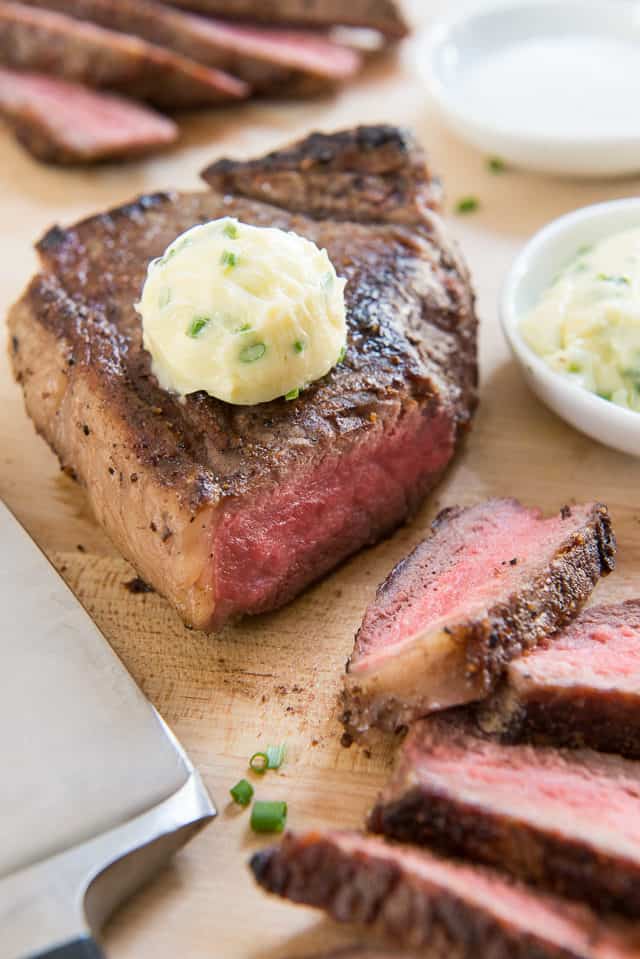
Because steaks are one of the easiest foods you can cook yourself, you'll never find me at a steakhouse.
Steaks are much more expensive at restaurants, and I have found it unnecessary to pay that premium when it's so easy to make at home.
A béarnaise sauce can be nice on occasion, but I usually don't bother with making sauce for steak at home, mainly because a good pan seared steak already tastes so fantastic.
You can also use it as the star ingredient for Steak Salad to have something a little different than the usual chicken.
A steak can taste incredible with a good seasoning of salt and pepper, and proper searing technique.
A little butter doesn't hurt either, and if you pair it with a side of homemade Potato Gratin too? That's an awesome dinner.
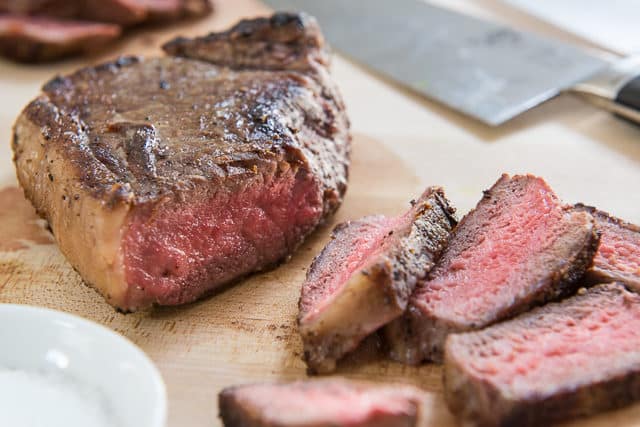
This post was originally published in January 2011, and since then I've seen many different methods for pan seared steak on the internet and in cookbooks. I recently experimented with a few of them to see if I liked new methods better.
The verdict? I still like this method the best.
It's very simple and gives the results I want, which is a browned outside and a rare interior.
And of course, you can cook it more if you prefer a more well done steak.
How to make restaurant quality steaks at home:
The way a steak is prepared makes all the difference in the flavor and tenderness of the meat.
The first thing you want to do is take your steaks out of the fridge an hour before cooking. This is really important and makes a big difference both with how evenly your steak cooks and how juicy it turns out. If it's cold straight out of the fridge, you have to cook the heck out of the outside in order to get the center up to rare.
Next, lay your steaks out on a board and blot them dry with a paper towel:
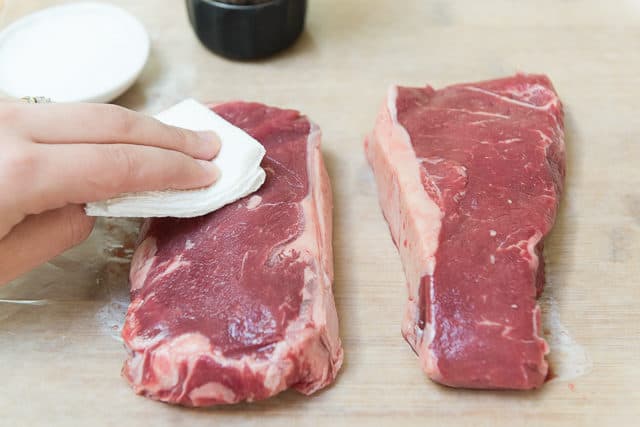
It may not seem like there's much moisture on the outside of the steaks, but look how a few dabs really wets the paper towel:
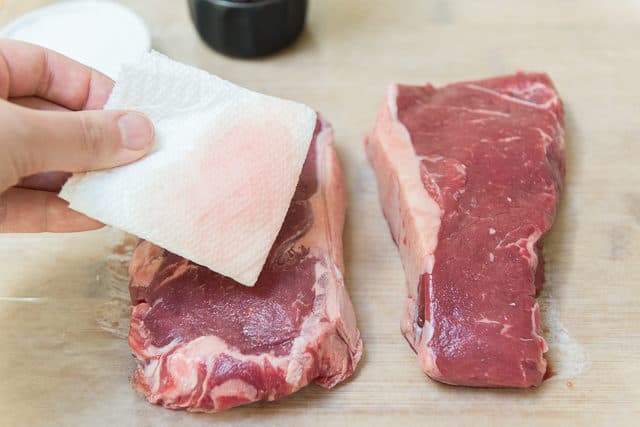
Excess moisture on the outside of your steak is the enemy of a caramelized and browned steak. This is because the moisture must first evaporate before the browning can happen, so you want to get rid of as much as possible from the start.
Now that the steak is dry, start heating up a cast iron skillet over high heat. I find cast iron to be the best for searing steaks because it's naturally nonstick, it retains heat wonderfully, and the material gives a better sear than a stainless steel pan.
If you don't have a cast iron skillet, well, you should buy one (it's $15 and will last you a lifetime), but if you don't have one right now, you can use any uncoated pan with good heat retention (heavy bottomed, copper core, etc). Do not use nonstick cookware, as the heat will be too high.
Additionally, pick a skillet that is close in size to your steak. If you use gigantic pan for a small steak, the uncovered areas will soon be covered in burned steak juices.
When the skillet is very hot, it's time to season the steaks. I add a generous sprinkle of salt:
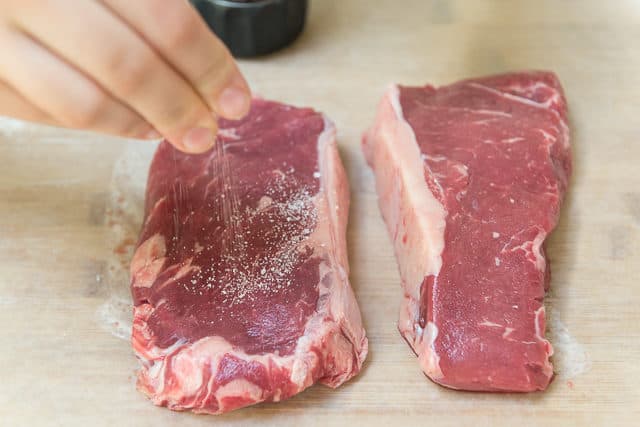
And a generous amount of black pepper:
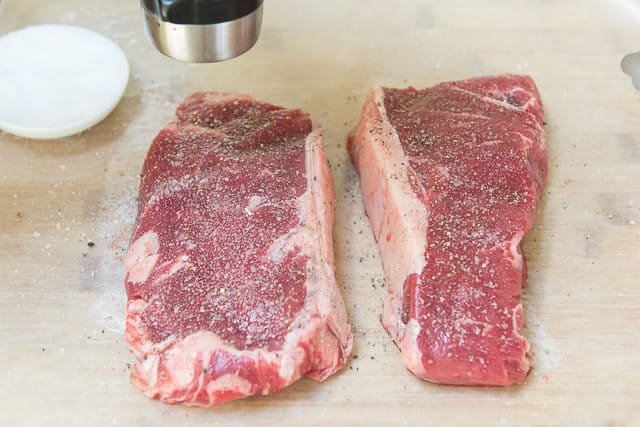
Important: You don't want to season the steaks with salt earlier than right before you cook them, otherwise the salt will draw out moisture and make the outside wet again.
Next, add about a teaspoon of oil to the pan, and spread it out with a brush:
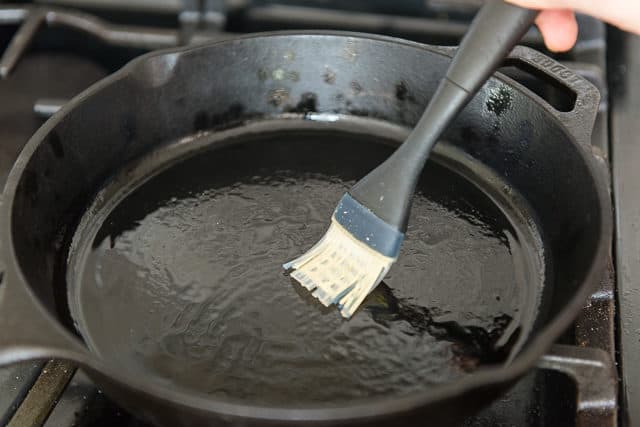
The reason I like to use a small amount of oil and brush it out, is then I don't have any issues with oil splattering. Make sure to use a high smoke point oil for this.
Add the steaks to the pan, making sure that you hear a loud sizzling noise when you do. If you don't hear a loud sear, the pan is not hot enough, and you should take the steaks out immediately and heat the pan higher and longer.
(Also, make sure the overhead fan is on while you cook since the high heat produces more smoke than low heat cooking).
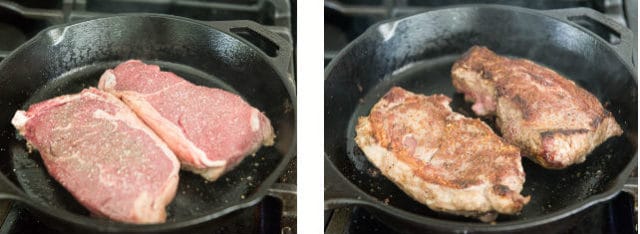
How long do you sear a steak for?
For a 1-inch thick piece, the steak should cook for about 3-4 minutes on each side for medium rare on a relatively high heat gas stove.
While the steak is cooking, don't touch it or move it at all. The steak should only be flipped one time, after that first 3-4 minute period when you check that the bottom is a beautiful golden brown color.
How do you know when the steak is done?
Because of variations in the strength of different stoves, it is helpful to have a thermometer (you can get a good one for less than $10), at least until you develop the ability to press a steak with your finger and know how done it is. If you press on the steak and it yields to your finger and feels soft, then it's still rare inside. Once the meat pushes back and it feels firm, it's cooked well done.
Here are the temperatures for steak doneness:
- Rare – 125°, very red inside, cool interior
- Medium rare – 135°, red inside and warm
- Medium – 145°, pink inside and warm
- Medium well – 150°, slightly pink inside and warm
- Well – 160°, no pink inside
Keep in mind that the steaks will cook another 5 degrees from carryover cooking after you remove them from the heat, so pull them a little early.
Always let your steak rest after searing
After you take your steak out of the pan, let it rest on a plate for 5 minutes. If you cut into it right away, all the tasty juices will run out onto your plate. Resting the steak gives it time for the juices to redistribute throughout, so your steak is nice and juicy.
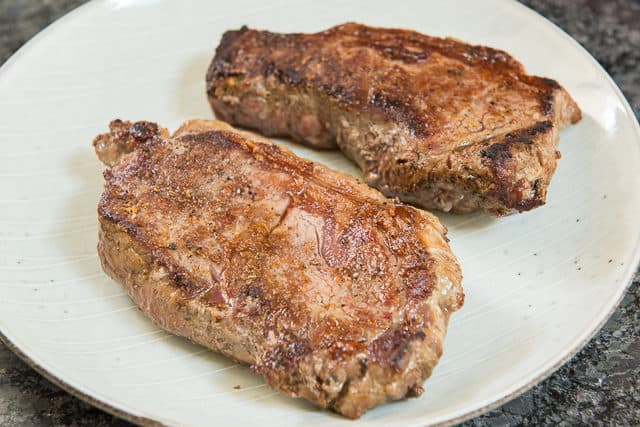
We often eat steak plain, just seasoned with salt and pepper before cooking, but sometimes I add a pat of butter, or I make a compound butter. All you have to do is soften salted butter and mix it with herbs, like chopped chives.
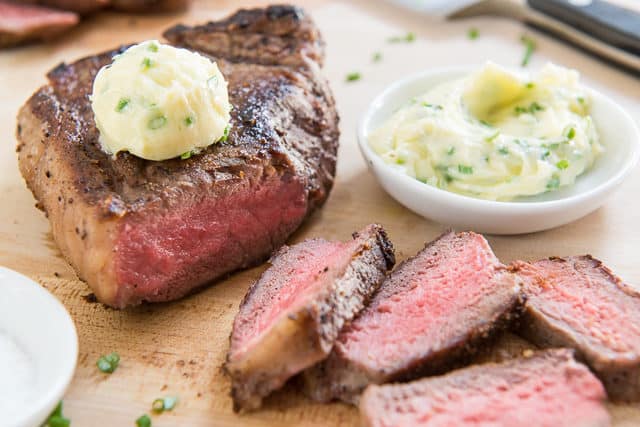
What to serve with steak:
- Potato Gratin – This is a classic side for steak and it's really hearty
- Crispy Smashed Potatoes – Potatoes are the perfect pairing for steak, and these have a nice crispiness
- Steak Fries – These are really easy to make and cook in the oven, and have a nice "heft" to them
- Roasted Parsnips – A vegetable side that has a really nice flavor with the steak
- Maple Glazed Carrots – So classic with steak, and has a lovely sweetness
- Roasted Brussel Sprouts – A healthy side option
Questions for pan seared steak:
Can you cook steaks from frozen? No, always thaw the steaks first. If you're in a hurry, you can thaw them in water.
Which steak is the best cut? Every cut has its merits, honestly. I recommend trying them all and deciding from there. My personal favorite is either ribeye or T-bone, though NY strip was my favorite for a long time.
How long can you store leftover steak? 1-2 days in the refrigerator. I don't recommend freezing.
How to reheat steak – I recommend doing it in the pan, for a couple minutes on each side over medium heat, just enough to rewarm it. You can do it in the microwave too, but you have to watch it more closely.
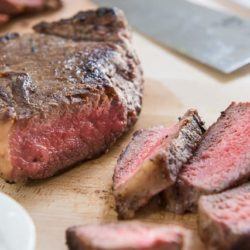
Pan Seared Steak
Servings: 1
Prep Time: 2 mins
Cook Time: 8 mins
Warm Up Time: 1 hr
Total Time: 1 hr 10 mins
Searing steak is so easy to do, I never order steak at restaurants anymore! Here are my top tips for a pan seared steak that is caramelized on the outside, and juicy in the middle.
For the Steak:
- 1 ribeye steak or porterhouse, strip, etc*
- salt to taste
- black pepper to taste
- 1 teaspoon oil (any high smoke point oil, like vegetable, avocado, etc)
-
60 minutes before cooking, remove the steaks from the fridge and let sit at room temperature.
-
Pat your steak as dry as you can with a paper towel.
-
Heat a cast iron skillet over medium high heat for several minutes, until the pan almost begins to smoke.
-
Season the steak all over with salt and pepper. I know how much salt to put on by eye, but 1/4 tsp for each side is about how much I do if you want to measure.
-
Use a brush to spread the oil out on the preheated skillet, then add the steaks. They should sizzle loudly.
-
Sear for 3-4 minutes on each side, until browned on the outside and medium rare on the inside.
-
Let the meat rest on a plate for at least 5 minutes after cooking. Enjoy!
*Please read the full post for notes on searing time and other tips. 3-4 minutes for each side is about right for a 1" thick steak for medium rare on a high powered gas stove.
If you are trying to cook super thick steaks like 1.5" and above, you will likely need to combine stovetop sear and oven. Sear for color, then pop the whole skillet into the oven to finish cooking. Otherwise, the exterior may burn by the time the middle part is up to temperature.
Calories: 928 kcal , Carbohydrates: 1 g , Protein: 64 g , Fat: 74 g , Saturated Fat: 31 g , Cholesterol: 238 mg , Sodium: 827 mg
Nutrition is estimated using a food database and is only intended to be used as a guideline for informational purposes.
Course: Main Course
Cuisine: American
This post contains affiliate links.
How to Cook a Steak Without a Cast Iron Skillet
Source: https://www.fifteenspatulas.com/how-to-properly-sear-a-steak/
0 Response to "How to Cook a Steak Without a Cast Iron Skillet"
Post a Comment